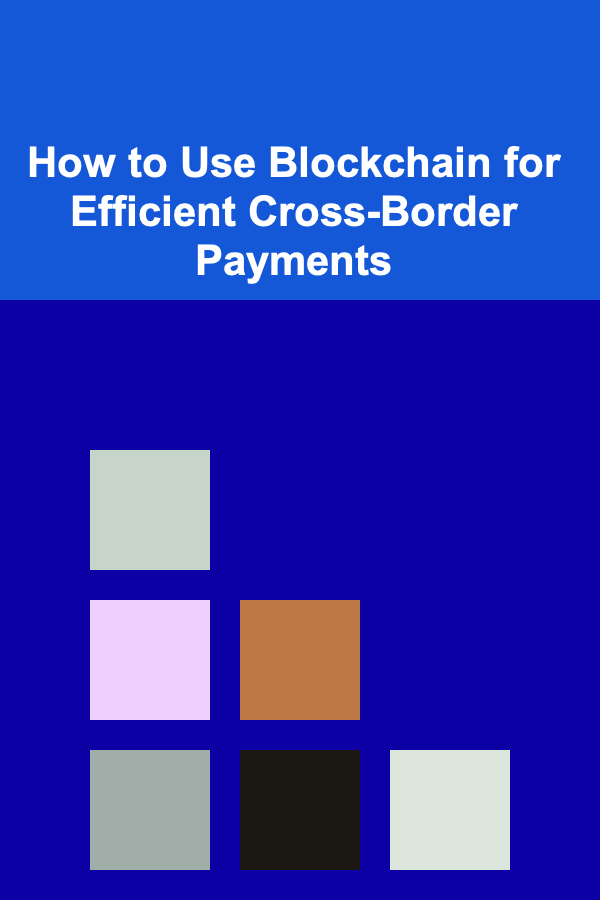
How to Use Blockchain for Efficient Cross-Border Payments
ebook include PDF & Audio bundle (Micro Guide)
$12.99$5.99
Limited Time Offer! Order within the next:

Cross-border payments have long been a challenge in the global financial ecosystem. Traditional methods, such as wire transfers, are often slow, expensive, and fraught with inefficiencies. The emergence of blockchain technology, however, has paved the way for revolutionary changes in how international transactions are conducted. By providing a decentralized, transparent, and secure platform for transferring funds, blockchain offers a solution to many of the issues that have historically plagued cross-border payments.
In this article, we explore how blockchain can be utilized to streamline cross-border payments. We will cover the technology behind blockchain, the existing challenges in cross-border payments, how blockchain addresses these challenges, and the benefits and limitations of adopting blockchain for international transactions. Additionally, we will look at real-world examples of blockchain-based solutions for cross-border payments.
Understanding Blockchain Technology
Blockchain is a distributed ledger technology that allows data to be stored across multiple computers in a way that ensures the integrity and transparency of the data. Each "block" in the chain contains a record of transactions, and once a block is added to the chain, it is immutable, meaning it cannot be altered or tampered with. This makes blockchain a powerful tool for applications where trust and security are paramount.
Key Characteristics of Blockchain
- Decentralization: Traditional payment systems rely on centralized institutions (such as banks) to facilitate transactions. Blockchain, however, is decentralized, meaning no single entity controls the network. Instead, the system is maintained by a network of participants (nodes), each of whom has a copy of the blockchain.
- Transparency: Every transaction recorded on a blockchain is visible to all participants in the network. This transparency helps ensure accountability and reduces the possibility of fraud.
- Immutability: Once a transaction is added to a blockchain, it cannot be altered or deleted. This makes blockchain an ideal solution for situations where trust and data integrity are critical.
- Security: Blockchain uses cryptographic techniques to secure transactions, making it highly resistant to hacking and fraud. Each transaction is verified through consensus mechanisms, which ensure that only valid transactions are added to the blockchain.
These characteristics make blockchain a promising technology for cross-border payments, as it provides a secure and transparent platform for conducting international transactions without relying on centralized intermediaries.
Challenges in Traditional Cross-Border Payments
Before delving into how blockchain can address these challenges, it is important to understand the key issues that exist in traditional cross-border payments.
1. High Transaction Costs
One of the main issues with traditional cross-border payments is the high transaction fees. Banks and payment service providers often charge hefty fees for processing international transactions. These fees can include:
- Transfer fees: Fees for processing the transfer itself, often based on the amount being sent.
- Currency conversion fees: Fees for converting between different currencies, which can be significant depending on the exchange rate and the amount being transferred.
- Correspondent bank fees: In some cases, the payment must pass through multiple intermediary banks (also known as correspondent banks) before reaching its destination. Each of these banks may charge a fee for their services.
These fees can add up quickly, making cross-border payments expensive, especially for small businesses or individuals sending smaller amounts of money.
2. Slow Processing Times
Traditional cross-border payments often take several days to process, particularly if the transaction involves multiple intermediary banks. For example, a bank transfer from the United States to India might take anywhere from 3 to 5 business days to complete, as the payment must pass through various banks, currency exchange processes, and clearinghouses.
The slow speed of these transactions is not only inconvenient but also inefficient, especially in an increasingly fast-paced global economy.
3. Lack of Transparency
In traditional payment systems, it can be difficult to track the progress of a cross-border transaction. Customers may not know where their money is in the process, and they may not receive updates until the transaction is complete. Additionally, the fees charged by intermediary banks are often opaque, making it unclear how much of the total payment is actually being received by the beneficiary.
This lack of transparency can lead to frustration and confusion for businesses and consumers alike.
4. Currency and Regulatory Barriers
Cross-border payments often involve converting between different currencies, which can be subject to fluctuating exchange rates. This introduces additional risks for both the sender and the receiver, as they may not know the exact amount of money that will be received until the transaction is completed.
Moreover, different countries have different regulatory requirements for cross-border payments, which can add layers of complexity. These regulations can delay or even block payments, especially in countries with strict capital controls or financial regulations.
How Blockchain Addresses Cross-Border Payment Challenges
Blockchain technology can provide solutions to many of the challenges associated with traditional cross-border payments. Let's explore how blockchain addresses each of the issues mentioned above.
1. Reducing Transaction Costs
Blockchain significantly reduces transaction costs by eliminating the need for intermediary banks and financial institutions. With blockchain, cross-border payments can be made directly between the sender and the receiver, cutting out the multiple layers of fees that are typically charged by banks and payment processors.
For example, a blockchain-based payment system like Ripple (XRP) allows businesses to send money directly across borders without needing to rely on correspondent banks or traditional financial networks. This reduces fees associated with currency conversion, intermediary charges, and transfer fees. In some cases, blockchain can reduce transaction costs by up to 60% compared to traditional methods.
2. Speeding Up Processing Times
Blockchain has the potential to dramatically speed up cross-border payments. While traditional transactions can take several days to process, blockchain transactions can be completed in a matter of minutes or even seconds.
This is because blockchain transactions do not require the same level of intermediaries or time-consuming validation processes. Instead of waiting for various banks to verify the transaction, blockchain uses a consensus mechanism to confirm the validity of the transaction. Once a transaction is verified, it is added to the blockchain, and the recipient can access the funds almost immediately.
For example, Stellar (XLM), another blockchain-based payment network, enables real-time cross-border payments with low fees. Stellar's platform processes transactions in just a few seconds, making it a faster and more efficient alternative to traditional cross-border payment systems.
3. Improving Transparency
Blockchain provides a high level of transparency, which is crucial for cross-border payments. Every transaction on a blockchain is recorded on the public ledger, making it visible to all participants in the network. This ensures that both the sender and the receiver can track the progress of the transaction in real-time.
Moreover, because blockchain transactions are immutable, there is a permanent and tamper-proof record of the transaction, which enhances trust and accountability. Both parties can see exactly how much money was transferred, when it was transferred, and any associated fees or charges.
This level of transparency reduces the risk of fraud and provides peace of mind for both businesses and consumers.
4. Overcoming Currency and Regulatory Barriers
Blockchain also has the potential to mitigate the challenges posed by currency conversion and regulatory barriers. Blockchain platforms like Ripple and Stellar allow users to send money in different currencies without having to rely on traditional currency exchange services. This reduces the risk of fluctuating exchange rates and ensures that both parties know exactly how much money will be received.
Additionally, blockchain allows for the creation of digital currencies and stablecoins that can be used for cross-border payments. For example, stablecoins are pegged to a stable asset like the US dollar, which helps minimize the risks associated with currency volatility. These digital assets can be easily transferred across borders, providing a stable and efficient medium for international transactions.
From a regulatory perspective, blockchain can also help streamline compliance processes. Smart contracts -- self-executing contracts with the terms of the agreement directly written into the code -- can be used to automate compliance checks, reducing the need for manual intervention and ensuring that transactions adhere to local regulations.
Real-World Blockchain Solutions for Cross-Border Payments
Several blockchain-based platforms have already begun to revolutionize the cross-border payments space. These platforms leverage the unique advantages of blockchain to offer faster, cheaper, and more transparent payment solutions.
1. Ripple (XRP)
Ripple is one of the most well-known blockchain-based payment networks for cross-border transactions. It uses the XRP token to facilitate international payments, enabling businesses to send money across borders with minimal fees and near-instant settlement times. Ripple's network is used by banks and financial institutions worldwide to process payments quickly and efficiently.
2. Stellar (XLM)
Stellar is another blockchain platform designed to facilitate cross-border payments. It aims to provide financial services to the unbanked and underbanked populations by enabling low-cost, fast, and secure payments. Stellar's decentralized exchange (DEX) allows users to send money across borders using a variety of different currencies, including stablecoins and fiat currencies.
3. SWIFT GPI and Blockchain Integration
SWIFT, the global financial messaging network, has been exploring the integration of blockchain technology into its cross-border payment systems. SWIFT GPI (Global Payments Innovation) is a service that allows for faster and more transparent international payments, and it has been working with blockchain-based solutions to improve its offerings.
4. IBM Blockchain and World Wire
IBM has developed a blockchain-based platform called World Wire, which enables real-time cross-border payments using stablecoins and digital assets. World Wire aims to connect banks, payment providers, and digital asset exchanges to create a more efficient and cost-effective payment ecosystem.
Benefits of Blockchain for Cross-Border Payments
- Cost Efficiency: By removing intermediaries, blockchain can significantly reduce transaction costs.
- Speed: Blockchain offers near-instant processing times, making cross-border payments faster than ever.
- Transparency: Blockchain provides full transparency of transactions, ensuring that both parties can track the payment in real-time.
- Security: Blockchain's cryptographic security ensures that transactions are tamper-proof and resistant to fraud.
- Accessibility: Blockchain opens up new opportunities for people in developing countries to access financial services and participate in the global economy.
Limitations and Challenges
- Regulatory Uncertainty: The regulatory landscape for blockchain and cryptocurrencies is still evolving, and some jurisdictions may impose restrictions on the use of blockchain for cross-border payments.
- Scalability: While blockchain has made significant strides in terms of transaction speed, scaling to handle large volumes of transactions remains a challenge.
- Adoption: Widespread adoption of blockchain for cross-border payments will require cooperation from banks, financial institutions, and regulatory bodies.
Conclusion
Blockchain has the potential to revolutionize cross-border payments by providing a more efficient, cost-effective, and secure alternative to traditional financial systems. By addressing key challenges such as high transaction costs, slow processing times, and lack of transparency, blockchain offers a promising solution for businesses and individuals seeking to send money across borders. While there are still challenges to overcome, the continued development and adoption of blockchain-based payment solutions could transform the global financial landscape.

How to Bake Delicious Pies and Tarts
Read More
How to Create a Checklist for Setting Professional Goals
Read More
How to Organize a Family Care Plan for Seniors
Read More
How to Teach Video Production on the Side in Your Free Time
Read More
How To Build a Simple Outdoor Table
Read More
How to Create Engaging Printable Board Game Storylines
Read MoreOther Products

How to Bake Delicious Pies and Tarts
Read More
How to Create a Checklist for Setting Professional Goals
Read More
How to Organize a Family Care Plan for Seniors
Read More
How to Teach Video Production on the Side in Your Free Time
Read More
How To Build a Simple Outdoor Table
Read More